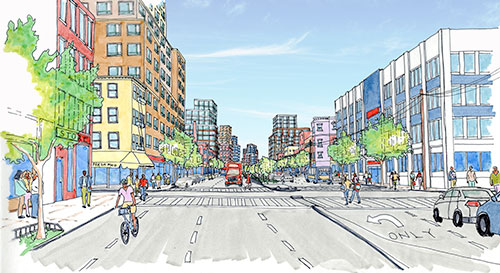The Department of City Planning (DCP) this week unveiled its rezoning plan for East New York as a template for similar plans that may gradually take effect in all DCP neighborhoods where the housing capacity is increasing. Individual applications, whether private or public, would also be subject to the program. Each development would go through its own land use review process.
“For the past three years, our Brooklyn office has been engaged in a planning process with the community of East New York – a vibrant neighborhood with residents from many cultures, strong community organizations and highly-committed elected officials. By bringing much-needed public investments and targeted programs to the neighborhood, this comprehensive plan will ensure that we’re not just adding housing, but we’re creating an improved, affordable and more livable East New York for longtime residents and newcomers alike,” said City Planning Commission Chairman Carl Weisbrod.
The East New York Community Plan will apply to a 190-block area of East New York, Cypress Hills and Ocean Hill, in Community Districts 5 and 16. The majority of the area is within East New York and Cypress Hills with Pennsylvania Avenue to the west, Conduit Boulevard to the East, Fulton Street to the north and Pitkin Avenue to the south.
In Ocean Hill, the 15-block area is between the Eastern Parkway Extension to the west, Van Sinderen Avenue to the east, Broadway to the north and East New York Avenue to the south.
The rezoning plan will create new residential and commercial zoning districts along the neighborhood’s busiest thoroughfares, including Atlantic Avenue, Fulton Street, Pitkin Avenue, and around Broadway Junction. Through the Mandatory Inclusionary Housing (MIH) program, all new buildings with more than 10 units will be required to offer permanently affordable housing. More than 6,000 new apartments could be created after the rezoning. Half of these would be priced at affordable rent levels for local residents.
The main priority of the NYC Department of Housing Preservation & Development (HPD) will be creating more than 1,200 affordable housing units in the next two years. Private sites that are subsidized by the HPD will be required to provide units that are affordable in relation to local income levels. Public sites will be required to provide units that are even more affordable to lower income residents.
Along with new housing, the City will also protect the existing affordable housing units. To fight back against displacement and harassment of residents, the City has set aside $36 million for legal representation in housing courts. To maintain affordability, the HPD will expand current financing and tax incentive programs in East New York. The City will take a proactive approach in reaching out to buildings with expiring regulatory agreements and work towards extending the agreements. Financial incentives will be offered to building owners making energy and water efficiency upgrades through the new Green Preservation Program. These savings can be passed on to tenants through rent protections.
The City will help to make improvements to the neighborhood’s services, infrastructures, and community resources. There is a plan in place to build a new 1,000-seat school in District 19, using city funds allocated to the area. The Atlantic Avenue Safety Improvement Project calls for a new planted median with pedestrian islands to allow for a safer corridor. The plan will make improvements to transportation as well, including the Broadway Junction Project, which will provide easier access to the transit station. Those who commute on their bicycles will also see a change as new bike lanes are added along Pitkin Avenue.
The Department of Environmental Protection will install new curbside bioswales, sloped landscape elements that absorb and manage storm water. These can reduce flooding during storms and help beautify the East New York streetscape.
Increased economic opportunity is a major concern for the area, after hearing from East New York residents. The Department of Small Business Services will place a satellite Workforce1 Career Center in the community. Employers will have access to free recruitment services. Potential employees can seek out employment services such as job placement, skills training, career advisement, and job search counseling. SBS will assess the needs of the commercial district and design a business growth course to guide business owners. The HPD will provide programs designed to support small businesses at the ground floor of housing buildings.
The rezoning wants to encourage commercial development and increase density along the main streets. However, along the quieter, more residential streets, contextual zoning districts will be established to preserve the character of the neighborhood.
Councilmembers Rafael Espinal and Inez Barron and Community Boards 5 and 6 worked alongside the U.S. Department of Housing and Urban Development to evaluate the needs and priorities of East New York. The DCP help workshops, forums, and visioning sessions to assess the community.
However, both Espinal and Barron do have some reported reservations about the plan.
The community boards have 60 days to review the proposal. After review, the proposal will go to the Borough President and the Brooklyn Borough Board, the City Planning Commission and the City Council as part of the City’s Uniform Land Use Review Procedure (ULURP).
For further information on the zoning proposal or the ULURP time table, please visit the DCP website at http://www.nyc.gov/html/dcp/html/east_new_york/index.shtml.







